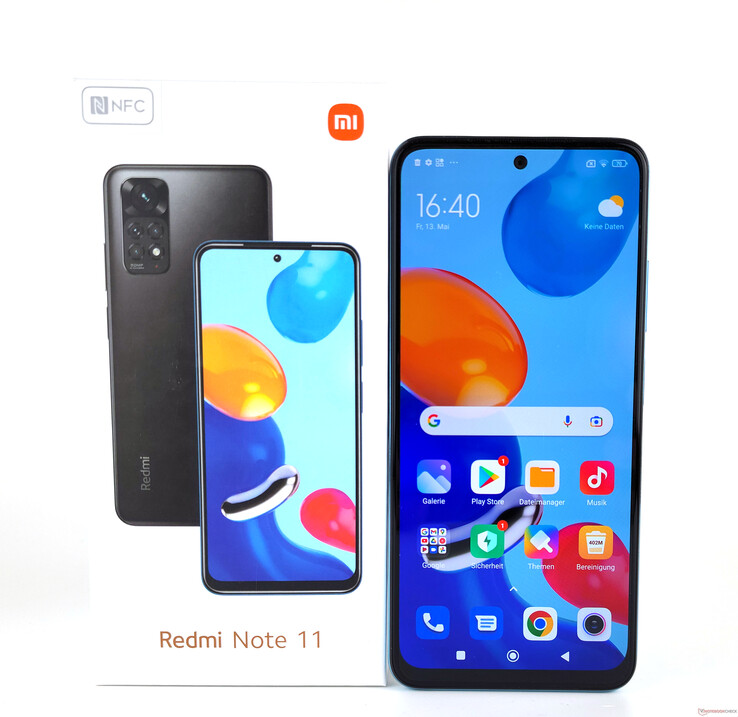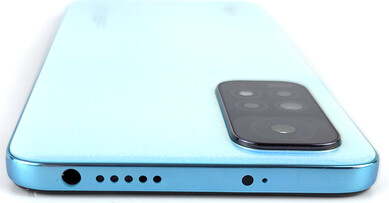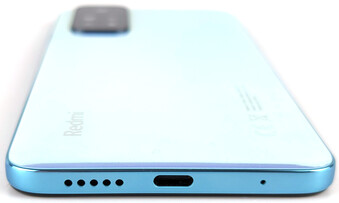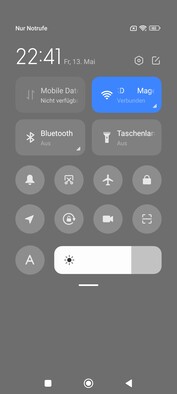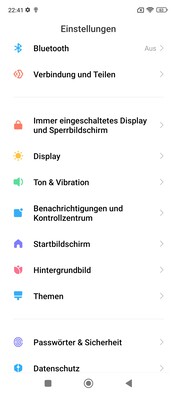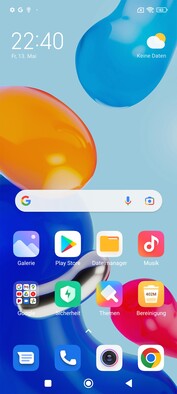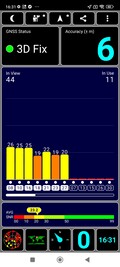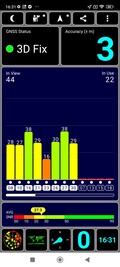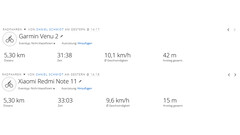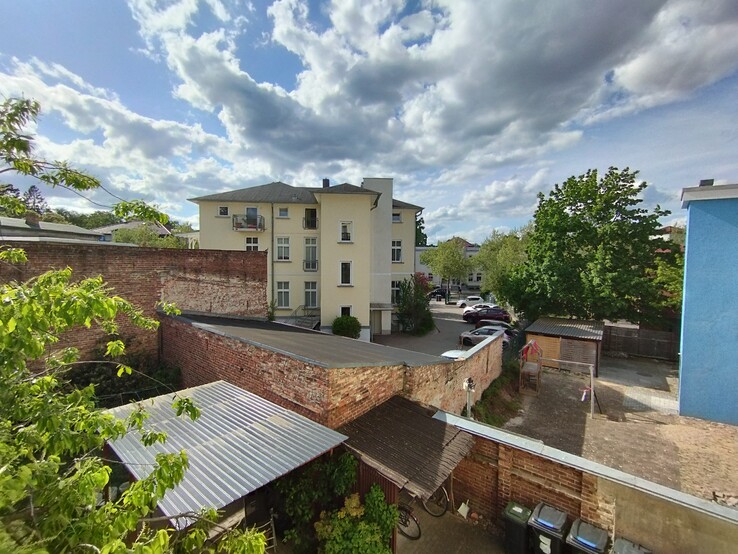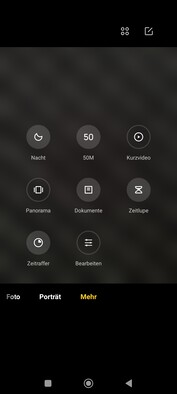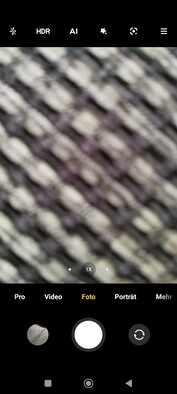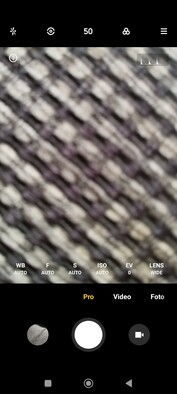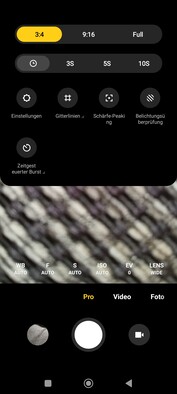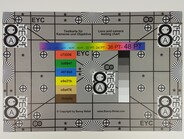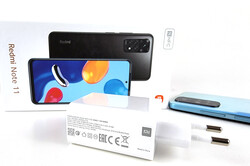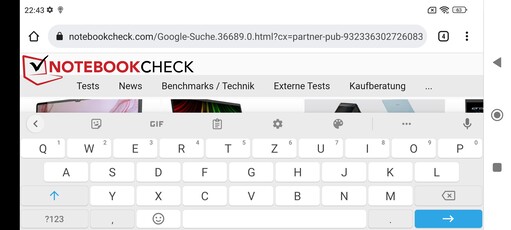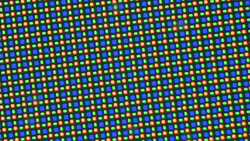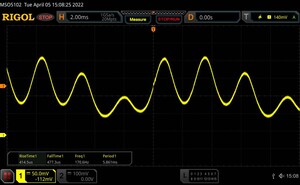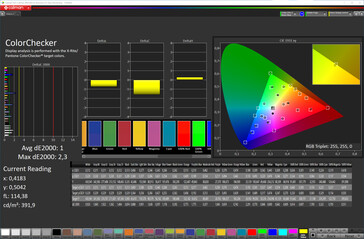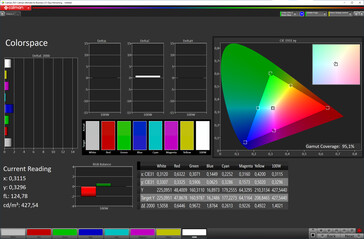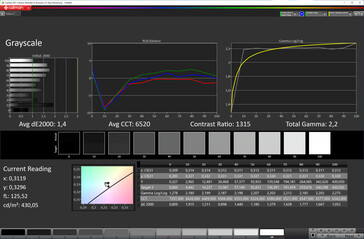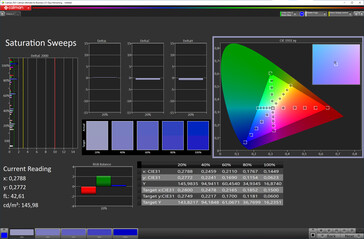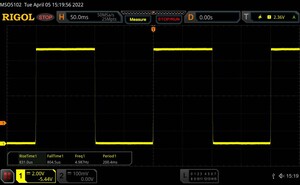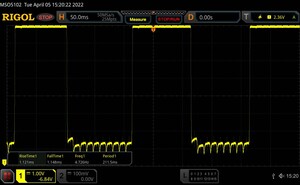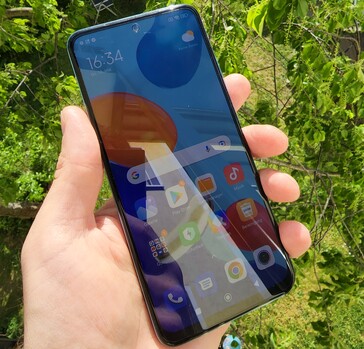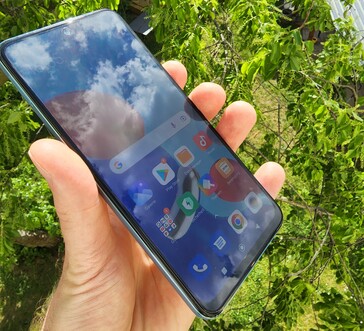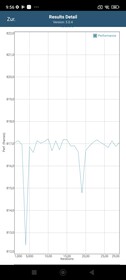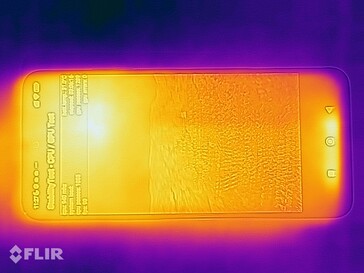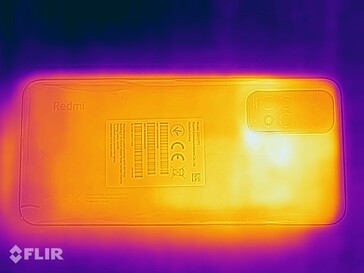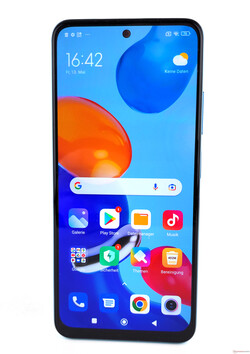Redmi Note 11 review: Xiaomi smartphone with a 90 Hz OLED display and 1,000 nits at an absolute bargain price
Although the Redmi Note 11 belongs to the low-priced mid-range, Xiaomi really excels when it comes to the display. The most affordable model of the Redmi Note 11 series, which was introduced in February, has a 6.43-inch AMOLED display with a 90 Hz refresh rate and a maximum brightness of up to 1,000 nits.
It's powered by a Qualcomm Snapdragon 680, which is accompanied by LPDDR4X RAM and UFS 2.2 storage. You can choose from the following model variants:
Redmi Note 11 | 64 GB | 4 GB RAM | 200 Euro (~$214) (MSRP)
Redmi Note 11 | 128 GB | 4 GB RAM | 230 Euro (~$247) (MSRP)
Redmi Note 11 | 128 GB | 4 GB RAM | 260 Euro (~$279) (MSRP)
The built-in 5,000 mAh battery supports 33-watt fast charging, and an appropriate 33-watt charger is included in the box. To round off the Redmi Note 11's features, there's a side-mounted fingerprint sensor and an integrated 3.5 mm audio jack.
Possible contenders in comparison
Rating | Date | Model | Weight | Drive | Size | Resolution | Price |
|---|---|---|---|---|---|---|---|
| 80 % v7 (old) | 05 / 2022 | Xiaomi Redmi Note 11 SD 680, Adreno 610 | 179 g | 64 GB UFS 2.2 Flash | 6.43" | 2400x1080 | |
| 75.1 % v7 (old) | 05 / 2022 | Motorola Moto G22 Helio G37, PowerVR GE8320 | 185 g | 64 GB eMMC Flash | 6.50" | 1600x720 | |
| 80.5 % v7 (old) | 01 / 2022 | Xiaomi Poco M4 Pro 5G Dimensity 810, Mali-G57 MP2 | 195 g | 128 GB UFS 2.2 Flash | 6.60" | 2400x1080 | |
| 77.6 % v7 (old) | 05 / 2022 | Realme C35 T7255 (T616), Mali-G57 MP1 | 189 g | 64 GB UFS 2.2 Flash | 6.60" | 2408x1080 | |
| 74.9 % v7 (old) | 12 / 2021 | Samsung Galaxy A12 Exynos SM-A127F Exynos 850, Mali-G52 MP1 | 205 g | 64 GB eMMC Flash | 6.50" | 1600x720 |
Case - Xiaomi smartphone with punch hole
The 179-gram Redmi Note 11 is available in three color options. Although the build quality is very impressive for this price range, the Xiaomi phone doesn't feel premium. Both the back and the frame are made of plastic, which is noticeable. The high-gloss finish of our Star Blue review sample barely hides fingerprints. However, users who choose the black version will get a satined plastic surface.
The IP53-certified Redmi phone features a flat OLED display at the front, which comes with a wide "chin". However, the competition in the affordable mid-range doesn't offer a much better ratio between the display and the front of the device, either. About 84.5% of the Redmi Note 11's front is dedicated to the AMOLED panel.
Connectivity - Redmi Note 11 with 3.5 mm audio jack
Given the price level of under 200 Euros (~$214), there are no real points of criticism for the Redmi Note 11 in terms of connectivity. The device comes with Miracast, UFS storage, a 3.5 mm headphone jack, and an IR blaster. Moreover, the internal storage can be expanded by up to 1 TB via microSD cards. In addition, external peripherals and storage devices can be connected via the USB port, but it only supports the 2.0 standard.
microSD card reader
The Redmi Note 11 has a triple card slot, which means that two nano SIM cards and one microSD card can be used in parallel. With our Angelbird V60 reference card, the speed is at a decent level. The SD card reader gets good transfer rates out of our storage medium in the Cross Platform Disk test, and the copy speed of about 25 MB/s is satisfactory as well.
| SD Card Reader - average JPG Copy Test (av. of 3 runs) | |
| Samsung Galaxy A12 Exynos SM-A127F (Angelbird V60) | |
| Xiaomi Redmi Note 11 (Angelbird AV Pro V60) | |
| Motorola Moto G22 (Angelbird V60) | |
| Realme C35 (Angelbird V60) | |
| Xiaomi Poco M4 Pro 5G (Angelbird AV Pro V60) | |
Cross Platform Disk Test (CPDT)
Software - Xiaomi phone with Android 11
Xiaomi combines the Android system with its in-house MIUI user interface on version 13. According to reports, the Redmi Note 11 will still be provided with security updates at 90-day intervals until 2025. Besides the upcoming upgrade to Android 12, it should also get an update to Android 13. We were unable to find official information from the manufacturer. At the time of our review, the Xiaomi phone is not up to date due to it running Android 11 and security patches from January 2022.
In MIUI 13, the Redmi Note 11 makes use of a redesigned MiSans font, a variety of new widgets, as well as support for Google's "Material You" design. What's somewhat unnecessary are the ad banners or ads displayed within the MIUI 13 interface, such as when an app is installed. However, these so-called MSA (MIUI System Ads) can generally be disabled quite easily. The existing bloatware, such as games or Netflix, can also be uninstalled.
Communication and GNSS - Xiaomi smartphone with NFC
When it comes to communication modules, Xiaomi uses an NFC chip for contactless payments via Google Pay as well as Bluetooth 5.0. Furthermore, the Qualcomm chipset in the Redmi Note 11 allows accessing the mobile Internet over 4G. The X11 modem doesn't support the 5G standard.
The Xiaomi phone covers a total of 12 LTE bands and all the relevant LTE frequencies for the German-speaking region, including the LTE Band 20 and the Band 28. However, the budget Redmi model isn't recommended for a trip abroad, e.g. to the USA, since it doesn't have bands 13 and 25.
The Note 11 offers solid transfer rates over Wi-Fi 5 networks. In combination with our Asus ROG Rapture GT-AXE11000 reference router, the Xiaomi phone is on par with the low-priced mid-range competition. Nevertheless, stability is quite low in our measurements.
| Networking | |
| iperf3 receive AXE11000 | |
| Average of class Smartphone (52 - 1857, n=181, last 2 years) | |
| Motorola Moto G22 | |
| Xiaomi Redmi Note 11 | |
| Realme C35 | |
| iperf3 transmit AXE11000 | |
| Average of class Smartphone (49.8 - 1828, n=181, last 2 years) | |
| Motorola Moto G22 | |
| Realme C35 | |
| Xiaomi Redmi Note 11 | |
| iperf3 transmit AX12 | |
| Samsung Galaxy A12 Exynos SM-A127F | |
| iperf3 receive AX12 | |
| Samsung Galaxy A12 Exynos SM-A127F | |
In order to assess the device's tracking capabilities in practice, we log a route with the Garmin Venu 2 for comparison purposes. The Redmi Note 11 determines its position via GPS (L1), GLONASS, BeiDou, and Galileo (E1). The satellite fix outdoors is fast and has an accuracy of about 4 meters. Even indoors, the Xiaomi phone determines its position quickly and accurately.
The deviations in the path are small, meaning that the routes are often identical for the mid-range phone and the smartwatch. The detailed GPS log reveals minor inaccuracies in the Redmi phone, though, especially when changing directions.
Telephone and call quality - Redmi Note 11 with dual-SIM feature
Cameras - Xiaomi smartphone with 50 MP
The 13 MP camera, which is located in the punch hole at the front, takes solid selfies in Photo mode. The Samsung S5K3L6 sensor reproduces subjects slightly softly and quite dully, and exposure could be better tuned as well.
The Redmi Note 11's rear-facing quad-camera system consists of a 50 MP main sensor from Samsung (S5KJN1), an 8 MP ultra wide-angle lens, as well as two 2 MP sensors for macro and depth photos. The Samsung ISOCELL JN1 has a sensor size of 1/2.76 inches, and it has an aperture of f/1.8 in the Redmi Note 11. By default, photos are taken in pixel-binning mode, so the images are 12.5 MP instead of 50 MP.
The results are more than decent for this price range - we really like the pictures taken with the affordable mid-range phone in very good light conditions in particular. The colors are also compelling with a vivid but not over-saturated representation. We can't determine any major deviations (DeltaE deviations >10) in our measurement with the ColorChecker Passport. However, image sharpness suffers with very distant subjects, and the dynamic range is rather low as well. Clear compromises have to be made in low light, although subjects are rendered much sharper than with other smartphones in this price range that are equipped with the Samsung ISOCELL JN1.
With a field of view of 118 degrees, a lot of image content can be captured with the ultra wide-angle lens that includes the GalaxyCore GC08A3 sensor. However, we see a lot of room for improvement in terms of quality here. The photos have many image errors, and the sharpness level is low. Nonetheless, the quality of the ultra wide-angle lens is still slightly above average for this price range.
Videos can only be recorded at up to 30 fps in Full HD quality with the Note 11 - this is a limitation of the Snapdragon 680, which doesn't support a UHD option. However, the device's poor stabilization doesn't exactly make the Xiaomi phone suitable for recording videos, either. Switching between the wide-angle and ultra wide-angle lens when filming isn't possible with the Redmi phone.
Image comparison
Choose a scene and navigate within the first image. One click changes the position on touchscreens. One click on the zoomed-in image opens the original in a new window. The first image shows the scaled photograph of the test device.
Wide angleWide angleLow lightUltra-wide angle5x zoom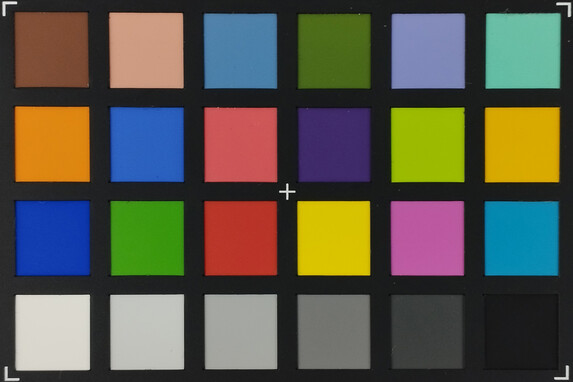

Accessories and warranty - Redmi Note 11 comes with charger
The low-priced mid-range phone comes with a modular 33-watt charger, a data and charging cable, a case, a SIM pin, and a Quick Start guide with warranty conditions. In addition, a screen protector comes installed by default.
The manufacturer grants a 12-month warranty on its phone.
Input devices and handling - Xiaomi smartphone with 180 Hz
The capacitive touchscreen detects inputs quickly and with precision, and the Gorilla Glass 3's gliding properties are equally compelling. At the same time, the built-in AMOLED panel is responsive with a sampling rate of up to 180 Hz, while it offers a refresh rate of 90 Hz, which makes animations and scrolling look pleasingly smooth.
An active fingerprint scanner that is integrated into the power button provides biometric security. It operates quickly and delivers good recognition rates. Unlocking the device with facial recognition via the front-facing camera is just as fast, but this 2D method is less secure.
Display - Redmi Note 11 with AMOLED display
The Redmi Note 11's 6.43-inch Dot Display is based on AMOLED technology. You can set its refresh rate to either 60 or 90 Hz. Adaptive control, such as the one observed in flagships, is not available here.
The Chinese manufacturer doesn't officially advertise an HDR10 certification, but according to the "DRM Info" app, the OLED panel, which has a resolution of 2400x1080 pixels, supports HDR content. Considering the brightness of 1,010 cd/m² (APL18) that we measured, users should also benefit from this. Using a completely white background, the Xiaomi phone manages a peak brightness of 702 cd/m², which is just as outstanding in this price range. The very even brightness distribution of the Dot Display is also worth mentioning.
Due to its technology, the Redmi Note 11 uses pulse width modulation (PWM) at a low frequency of 90 to 171 Hz for brightness control. The OLED flickering in the Xiaomi smartphone starts at 55% of the maximum brightness and runs at a constant 90 Hz with a very low and even amplitude curve. We didn't find a DC dimming mode in the settings menu.
| |||||||||||||||||||||||||
Brightness Distribution: 98 %
Center on Battery: 702 cd/m²
Contrast: ∞:1 (Black: 0 cd/m²)
ΔE ColorChecker Calman: 1 | ∀{0.5-29.43 Ø4.78}
ΔE Greyscale Calman: 1.4 | ∀{0.09-98 Ø5}
95.1% sRGB (Calman 2D)
Gamma: 2.2
CCT: 6520 K
| Xiaomi Redmi Note 11 OLED, 2400x1080, 6.4" | Motorola Moto G22 IPS LCD, 1600x720, 6.5" | Xiaomi Poco M4 Pro 5G TFT-LCD, 2400x1080, 6.6" | Realme C35 IPS, 2408x1080, 6.6" | Samsung Galaxy A12 Exynos SM-A127F IPS LCD, 1600x720, 6.5" | |
|---|---|---|---|---|---|
| Screen | -188% | -108% | -165% | -171% | |
| Brightness middle (cd/m²) | 702 | 451 -36% | 504 -28% | 585 -17% | 446 -36% |
| Brightness (cd/m²) | 701 | 431 -39% | 499 -29% | 558 -20% | 423 -40% |
| Brightness Distribution (%) | 98 | 90 -8% | 91 -7% | 89 -9% | 88 -10% |
| Black Level * (cd/m²) | 0.5 | 0.72 | 0.6 | 0.29 | |
| Colorchecker dE 2000 * | 1 | 5.82 -482% | 3.3 -230% | 4.4 -340% | 4.94 -394% |
| Colorchecker dE 2000 max. * | 2.3 | 9.3 -304% | 6 -161% | 8.77 -281% | 8.81 -283% |
| Greyscale dE 2000 * | 1.4 | 5 -257% | 4.1 -193% | 5.9 -321% | 5.1 -264% |
| Gamma | 2.2 100% | 2.776 79% | 2.28 96% | 2.228 99% | 2.145 103% |
| CCT | 6520 100% | 7683 85% | 7041 92% | 8001 81% | 7890 82% |
| Contrast (:1) | 902 | 700 | 975 | 1538 |
* ... smaller is better
Screen Flickering / PWM (Pulse-Width Modulation)
| Screen flickering / PWM detected | 171.4 Hz | ||
The display backlight flickers at 171.4 Hz (worst case, e.g., utilizing PWM) . The frequency of 171.4 Hz is relatively low, so sensitive users will likely notice flickering and experience eyestrain at the stated brightness setting and below. In comparison: 53 % of all tested devices do not use PWM to dim the display. If PWM was detected, an average of 8111 (minimum: 5 - maximum: 343500) Hz was measured. | |||
Series of measurements with a fixed zoom level and different brightness settings
When it comes to the display, the Redmi Note 11 doesn't lack any configuration options. Users can choose from three different profiles and customize the color temperature to their personal taste. However, individual display parameters, such as saturation or gamma, can't be tweaked.
In our tests with the CalMAN software and a spectrophotometer, the AMOLED panel proves to be very well calibrated, and it hardly shows any color deviations in the "Standard" profile. Due to the OLED technology, where individual pixels can be completely switched off, an "absolute" black is achieved, and contrast (theoretically) tends towards infinity.
Display Response Times
| ↔ Response Time Black to White | ||
|---|---|---|
| 1.635 ms ... rise ↗ and fall ↘ combined | ↗ 0.831 ms rise | |
| ↘ 0.8045 ms fall | ||
| The screen shows very fast response rates in our tests and should be very well suited for fast-paced gaming. In comparison, all tested devices range from 0.1 (minimum) to 240 (maximum) ms. » 8 % of all devices are better. This means that the measured response time is better than the average of all tested devices (20.2 ms). | ||
| ↔ Response Time 50% Grey to 80% Grey | ||
| 1.135 ms ... rise ↗ and fall ↘ combined | ↗ 1.121 ms rise | |
| ↘ 1.148 ms fall | ||
| The screen shows very fast response rates in our tests and should be very well suited for fast-paced gaming. In comparison, all tested devices range from 0.165 (minimum) to 636 (maximum) ms. » 4 % of all devices are better. This means that the measured response time is better than the average of all tested devices (31.6 ms). | ||
Thanks to the high brightness, the Redmi Note 11 is also optimally equipped for everyday use outdoors. However, the automatic brightness feature should be activated here. Otherwise, the Xiaomi phone stops at 445 cd/m2. Screen content remains legible even in direct sunlight and under the accompanying reflections on the glass surface.
The AMOLED panel's viewing-angle stability is very good, and only at very flat viewing angles is a slight brightness loss noticeable.
Performance - Redmi Note 11 with Qualcomm SoC
A Qualcomm Snapdragon 680 powers the Redmi Note 11. The SoC, which has been manufactured in a 6 nm process, has four Cortex-A73 cores (2.4 GHz) and four Cortex-A53 cores (1.8 GHz). An Adreno 610 is integrated as graphics unit.
The Redmi phone ranks behind the Poco M4 Pro in our benchmark package, although the latter also has a bit more RAM at its disposal. Compared with its sibling model, the single-core rates in Geekbench in particular turn out to be lower.
| CrossMark - Overall | |
| Average of class Smartphone (187 - 2674, n=127, last 2 years) | |
| Xiaomi Redmi Note 11 | |
| Average Qualcomm Snapdragon 680 4G (325 - 419, n=9) | |
| Motorola Moto G22 | |
| AImark - Score v2.x | |
| Xiaomi Poco M4 Pro 5G | |
| Xiaomi Redmi Note 11 | |
| Realme 9i | |
| Average Qualcomm Snapdragon 680 4G (4320 - 4995, n=5) | |
| Realme C35 | |
| Samsung Galaxy A12 Exynos SM-A127F | |
| Motorola Moto G22 | |
| UL Procyon AI Inference for Android - Overall Score NNAPI | |
| Average of class Smartphone (3769 - 81594, n=139, last 2 years) | |
| Xiaomi Poco M4 Pro 5G | |
| Xiaomi Redmi Note 11 | |
| Realme 9i | |
| Average Qualcomm Snapdragon 680 4G (3820 - 4853, n=7) | |
| Realme C35 | |
| Motorola Moto G22 | |
| VRMark - Amber Room | |
| Xiaomi Poco M4 Pro 5G | |
| Xiaomi Redmi Note 11 | |
| Average Qualcomm Snapdragon 680 4G (n=1) | |
| Realme C35 | |
The Redmi Note 11 also performs solidly in the graphics benchmarks. Although the Poco M4 Pro occasionally scores twice as high with its Dimensity 810, the Snapdragon 680 still performs satisfactorily in relation to the comparison field.
GFXBench (DX / GLBenchmark) 2.7: T-Rex Onscreen | 1920x1080 T-Rex Offscreen
GFXBench 3.0: on screen Manhattan Onscreen OGL | 1920x1080 1080p Manhattan Offscreen
GFXBench 3.1: on screen Manhattan ES 3.1 Onscreen | 1920x1080 Manhattan ES 3.1 Offscreen
GFXBench: on screen Car Chase Onscreen | 1920x1080 Car Chase Offscreen | on screen Aztec Ruins High Tier Onscreen | 2560x1440 Aztec Ruins High Tier Offscreen | on screen Aztec Ruins Normal Tier Onscreen | 1920x1080 Aztec Ruins Normal Tier Offscreen
Basemark ES 3.1 / Metal: offscreen Overall Score
Basemark GPU 1.2: OpenGL Medium Native | 1920x1080 OpenGL Medium Offscreen | Vulkan Medium Native | 1920x1080 Vulkan Medium Offscreen
| 3DMark / Wild Life Extreme Unlimited | |
| Xiaomi Poco M4 Pro 5G | |
| Realme C35 | |
| Xiaomi Redmi Note 11 | |
| Samsung Galaxy A12 Exynos SM-A127F | |
| Realme 9i | |
| 3DMark / Wild Life Extreme | |
| Xiaomi Poco M4 Pro 5G | |
| Realme C35 | |
| Xiaomi Redmi Note 11 | |
| Samsung Galaxy A12 Exynos SM-A127F | |
| Realme 9i | |
| 3DMark / Wild Life Unlimited Score | |
| Xiaomi Poco M4 Pro 5G | |
| Realme C35 | |
| Xiaomi Redmi Note 11 | |
| Samsung Galaxy A12 Exynos SM-A127F | |
| Realme 9i | |
| 3DMark / Wild Life Score | |
| Xiaomi Poco M4 Pro 5G | |
| Realme C35 | |
| Xiaomi Redmi Note 11 | |
| Realme 9i | |
| Samsung Galaxy A12 Exynos SM-A127F | |
| Motorola Moto G22 | |
| 3DMark / Sling Shot Extreme (Vulkan) Unlimited Physics | |
| Xiaomi Poco M4 Pro 5G | |
| Realme C35 | |
| Realme 9i | |
| Xiaomi Redmi Note 11 | |
| Motorola Moto G22 | |
| Samsung Galaxy A12 Exynos SM-A127F | |
| 3DMark / Sling Shot Extreme (Vulkan) Unlimited Graphics | |
| Xiaomi Poco M4 Pro 5G | |
| Xiaomi Redmi Note 11 | |
| Realme 9i | |
| Realme C35 | |
| Samsung Galaxy A12 Exynos SM-A127F | |
| Motorola Moto G22 | |
| 3DMark / Sling Shot Extreme (Vulkan) Unlimited | |
| Xiaomi Poco M4 Pro 5G | |
| Realme 9i | |
| Xiaomi Redmi Note 11 | |
| Realme C35 | |
| Samsung Galaxy A12 Exynos SM-A127F | |
| Motorola Moto G22 | |
| 3DMark / Sling Shot Extreme (ES 3.1) Unlimited Physics | |
| Xiaomi Poco M4 Pro 5G | |
| Realme C35 | |
| Realme 9i | |
| Xiaomi Redmi Note 11 | |
| Samsung Galaxy A12 Exynos SM-A127F | |
| Motorola Moto G22 | |
| 3DMark / Sling Shot Extreme (ES 3.1) Unlimited Graphics | |
| Xiaomi Poco M4 Pro 5G | |
| Xiaomi Redmi Note 11 | |
| Realme 9i | |
| Realme C35 | |
| Samsung Galaxy A12 Exynos SM-A127F | |
| Motorola Moto G22 | |
| 3DMark / Sling Shot Extreme (ES 3.1) Unlimited | |
| Xiaomi Poco M4 Pro 5G | |
| Xiaomi Redmi Note 11 | |
| Realme 9i | |
| Realme C35 | |
| Samsung Galaxy A12 Exynos SM-A127F | |
| Motorola Moto G22 | |
| 3DMark / Sling Shot OpenGL ES 3.0 Physics | |
| Xiaomi Poco M4 Pro 5G | |
| Realme C35 | |
| Realme 9i | |
| Xiaomi Redmi Note 11 | |
| Samsung Galaxy A12 Exynos SM-A127F | |
| Motorola Moto G22 | |
| 3DMark / Sling Shot OpenGL ES 3.0 Graphics | |
| Xiaomi Poco M4 Pro 5G | |
| Xiaomi Redmi Note 11 | |
| Realme 9i | |
| Realme C35 | |
| Samsung Galaxy A12 Exynos SM-A127F | |
| Motorola Moto G22 | |
| 3DMark / Sling Shot OpenGL ES 3.0 | |
| Xiaomi Poco M4 Pro 5G | |
| Realme 9i | |
| Xiaomi Redmi Note 11 | |
| Realme C35 | |
| Samsung Galaxy A12 Exynos SM-A127F | |
| Motorola Moto G22 | |
| 3DMark / Sling Shot Extreme (ES 3.1) | |
| Xiaomi Poco M4 Pro 5G | |
| Xiaomi Redmi Note 11 | |
| Realme 9i | |
| Realme C35 | |
| Samsung Galaxy A12 Exynos SM-A127F | |
| Motorola Moto G22 | |
| 3DMark / Sling Shot Extreme (ES 3.1) Graphics | |
| Xiaomi Poco M4 Pro 5G | |
| Xiaomi Redmi Note 11 | |
| Realme 9i | |
| Realme C35 | |
| Samsung Galaxy A12 Exynos SM-A127F | |
| Motorola Moto G22 | |
| 3DMark / Sling Shot Extreme (ES 3.1) Physics | |
| Xiaomi Poco M4 Pro 5G | |
| Realme C35 | |
| Realme 9i | |
| Xiaomi Redmi Note 11 | |
| Samsung Galaxy A12 Exynos SM-A127F | |
| Motorola Moto G22 | |
| 3DMark / Sling Shot OpenGL ES 3.0 Unlimited | |
| Xiaomi Poco M4 Pro 5G | |
| Realme 9i | |
| Xiaomi Redmi Note 11 | |
| Realme C35 | |
| Samsung Galaxy A12 Exynos SM-A127F | |
| Motorola Moto G22 | |
| 3DMark / Sling Shot OpenGL ES 3.0 Unlimited Graphics | |
| Xiaomi Poco M4 Pro 5G | |
| Realme 9i | |
| Xiaomi Redmi Note 11 | |
| Realme C35 | |
| Samsung Galaxy A12 Exynos SM-A127F | |
| Motorola Moto G22 | |
| 3DMark / Sling Shot OpenGL ES 3.0 Unlimited Physics | |
| Xiaomi Poco M4 Pro 5G | |
| Realme C35 | |
| Realme 9i | |
| Xiaomi Redmi Note 11 | |
| Samsung Galaxy A12 Exynos SM-A127F | |
| Motorola Moto G22 | |
| GFXBench (DX / GLBenchmark) 2.7 / T-Rex Onscreen | |
| Xiaomi Poco M4 Pro 5G | |
| Xiaomi Redmi Note 11 | |
| Realme 9i | |
| Samsung Galaxy A12 Exynos SM-A127F | |
| Motorola Moto G22 | |
| Realme C35 | |
| GFXBench (DX / GLBenchmark) 2.7 / T-Rex Offscreen | |
| Xiaomi Poco M4 Pro 5G | |
| Xiaomi Redmi Note 11 | |
| Realme 9i | |
| Realme C35 | |
| Samsung Galaxy A12 Exynos SM-A127F | |
| Motorola Moto G22 | |
| GFXBench 3.0 / Manhattan Onscreen OGL | |
| Xiaomi Poco M4 Pro 5G | |
| Samsung Galaxy A12 Exynos SM-A127F | |
| Realme 9i | |
| Motorola Moto G22 | |
| Xiaomi Redmi Note 11 | |
| Realme C35 | |
| GFXBench 3.0 / 1080p Manhattan Offscreen | |
| Xiaomi Poco M4 Pro 5G | |
| Realme 9i | |
| Xiaomi Redmi Note 11 | |
| Samsung Galaxy A12 Exynos SM-A127F | |
| Realme C35 | |
| Motorola Moto G22 | |
| GFXBench 3.1 / Manhattan ES 3.1 Onscreen | |
| Xiaomi Poco M4 Pro 5G | |
| Samsung Galaxy A12 Exynos SM-A127F | |
| Realme 9i | |
| Xiaomi Redmi Note 11 | |
| Motorola Moto G22 | |
| Realme C35 | |
| GFXBench 3.1 / Manhattan ES 3.1 Offscreen | |
| Xiaomi Poco M4 Pro 5G | |
| Xiaomi Redmi Note 11 | |
| Realme 9i | |
| Realme C35 | |
| Samsung Galaxy A12 Exynos SM-A127F | |
| Motorola Moto G22 | |
| GFXBench / Car Chase Onscreen | |
| Xiaomi Poco M4 Pro 5G | |
| Samsung Galaxy A12 Exynos SM-A127F | |
| Xiaomi Redmi Note 11 | |
| Realme 9i | |
| Motorola Moto G22 | |
| Realme C35 | |
| GFXBench / Car Chase Offscreen | |
| Xiaomi Poco M4 Pro 5G | |
| Xiaomi Redmi Note 11 | |
| Realme 9i | |
| Samsung Galaxy A12 Exynos SM-A127F | |
| Realme C35 | |
| Motorola Moto G22 | |
| GFXBench / Aztec Ruins High Tier Onscreen | |
| Xiaomi Poco M4 Pro 5G | |
| Samsung Galaxy A12 Exynos SM-A127F | |
| Realme 9i | |
| Xiaomi Redmi Note 11 | |
| Motorola Moto G22 | |
| Realme C35 | |
| GFXBench / Aztec Ruins High Tier Offscreen | |
| Xiaomi Poco M4 Pro 5G | |
| Realme 9i | |
| Xiaomi Redmi Note 11 | |
| Samsung Galaxy A12 Exynos SM-A127F | |
| Realme C35 | |
| Motorola Moto G22 | |
| GFXBench / Aztec Ruins Normal Tier Onscreen | |
| Xiaomi Poco M4 Pro 5G | |
| Samsung Galaxy A12 Exynos SM-A127F | |
| Xiaomi Redmi Note 11 | |
| Realme 9i | |
| Motorola Moto G22 | |
| Realme C35 | |
| GFXBench / Aztec Ruins Normal Tier Offscreen | |
| Xiaomi Poco M4 Pro 5G | |
| Xiaomi Redmi Note 11 | |
| Realme 9i | |
| Samsung Galaxy A12 Exynos SM-A127F | |
| Realme C35 | |
| Motorola Moto G22 | |
| Basemark ES 3.1 / Metal / Overall Score | |
| Xiaomi Poco M4 Pro 5G | |
| Realme C35 | |
| Realme 9i | |
| Xiaomi Redmi Note 11 | |
| Motorola Moto G22 | |
| Basemark GPU 1.2 / OpenGL Medium Native | |
| Xiaomi Poco M4 Pro 5G | |
| Motorola Moto G22 | |
| Xiaomi Redmi Note 11 | |
| Realme 9i | |
| Basemark GPU 1.2 / OpenGL Medium Offscreen | |
| Xiaomi Poco M4 Pro 5G | |
| Realme 9i | |
| Xiaomi Redmi Note 11 | |
| Motorola Moto G22 | |
| Basemark GPU 1.2 / Vulkan Medium Native | |
| Xiaomi Poco M4 Pro 5G | |
| Xiaomi Redmi Note 11 | |
| Realme 9i | |
| Motorola Moto G22 | |
| Basemark GPU 1.2 / Vulkan Medium Offscreen | |
| Xiaomi Poco M4 Pro 5G | |
| Realme 9i | |
| Xiaomi Redmi Note 11 | |
| Jetstream 2 - 2.0 Total Score | |
| Average of class Smartphone (23.8 - 387, n=153, last 2 years) | |
| Average Qualcomm Snapdragon 680 4G (35.7 - 66, n=9) | |
| Realme C35 (Chrome 101) | |
| Xiaomi Poco M4 Pro 5G (Chrome 96) | |
| Xiaomi Redmi Note 11 (Chrome 101) | |
| Samsung Galaxy A12 Exynos SM-A127F (Chrome96) | |
| Motorola Moto G22 (Chrome101) | |
| JetStream 1.1 - Total Score | |
| Xiaomi Poco M4 Pro 5G (Chrome 96) | |
| Average Qualcomm Snapdragon 680 4G (69 - 78.9, n=3) | |
| Xiaomi Redmi Note 11 (Chrome 101) | |
| Samsung Galaxy A12 Exynos SM-A127F (Chrome96) | |
| Speedometer 2.0 - Result 2.0 | |
| Average of class Smartphone (15.2 - 643, n=126, last 2 years) | |
| Average Qualcomm Snapdragon 680 4G (32.7 - 65.3, n=9) | |
| Xiaomi Poco M4 Pro 5G (Chrome 96) | |
| Xiaomi Redmi Note 11 (Chrome 101) | |
| Realme C35 | |
| Samsung Galaxy A12 Exynos SM-A127F (Chrome96) | |
| Motorola Moto G22 (Chrome101) | |
| WebXPRT 3 - Overall | |
| Average of class Smartphone (38 - 380, n=34, last 2 years) | |
| Average Qualcomm Snapdragon 680 4G (58 - 94, n=7) | |
| Xiaomi Redmi Note 11 (Chrome 101) | |
| Xiaomi Poco M4 Pro 5G (Chrome 96) | |
| Samsung Galaxy A12 Exynos SM-A127F (Chrome96) | |
| Motorola Moto G22 (Chrome101) | |
| Octane V2 - Total Score | |
| Average of class Smartphone (2228 - 121337, n=201, last 2 years) | |
| Xiaomi Poco M4 Pro 5G (Chrome 96) | |
| Xiaomi Redmi Note 11 (Chrome 101) | |
| Average Qualcomm Snapdragon 680 4G (6358 - 16498, n=13) | |
| Samsung Galaxy A12 Exynos SM-A127F (Chrome96) | |
| Motorola Moto G22 (Chrome101) | |
| Mozilla Kraken 1.1 - Total | |
| Motorola Moto G22 (Chrome101) | |
| Samsung Galaxy A12 Exynos SM-A127F (Chrome96) | |
| Xiaomi Redmi Note 11 (Chrome 101) | |
| Average Qualcomm Snapdragon 680 4G (2459 - 3461, n=8) | |
| Xiaomi Poco M4 Pro 5G (Chrome 96) | |
| Average of class Smartphone (257 - 28190, n=156, last 2 years) | |
* ... smaller is better
The Redmi Note 11 runs smoothly most of the time in everyday use, but minor stuttering is always present. System performance is absolutely fine for this price range, and application load times are also pleasingly short. This is also due to the moderate read and write rates provided by the UFS storage. The write rates in particular are very good in the Redmi Note 11.
| Xiaomi Redmi Note 11 | Motorola Moto G22 | Xiaomi Poco M4 Pro 5G | Realme C35 | Samsung Galaxy A12 Exynos SM-A127F | Average 64 GB UFS 2.2 Flash | Average of class Smartphone | |
|---|---|---|---|---|---|---|---|
| AndroBench 3-5 | -80% | -3% | -10% | -70% | -9% | 144% | |
| Sequential Read 256KB (MB/s) | 895.34 | 215.45 -76% | 964 8% | 907.1 1% | 302.3 -66% | 770 ? -14% | 2216 ? 148% |
| Sequential Write 256KB (MB/s) | 519.23 | 112.78 -78% | 471 -9% | 271.1 -48% | 74.5 -86% | 399 ? -23% | 1837 ? 254% |
| Random Read 4KB (MB/s) | 172.95 | 39.32 -77% | 148.8 -14% | 137.8 -20% | 77.8 -55% | 156.6 ? -9% | 294 ? 70% |
| Random Write 4KB (MB/s) | 163.29 | 16.34 -90% | 171.8 5% | 206.4 26% | 47.21 -71% | 177.7 ? 9% | 334 ? 105% |
Games - Xiaomi smartphone achieves 60 fps
Although the built-in Adreno 610 is a bit outdated, the graphics performance, which we tested with our partner GameBench, should be sufficient for the occasional Android game.
PUBG Mobile can only be played at minimum details - the HD and UHD settings can't be selected - but the shooter is displayed at a relatively constant 25 fps. 30 fps can be achieved using the lowest detail settings.
Armajet, our second test game, is also limited to 30 fps, which is a bit surprising since the arena shooter theoretically supports 144 fps, and other smartphones with the Adreno 610, such as the realme 9i, manage 60 fps. The situation is better in League of Legends: Wild Rift, where a frame rate of 60 fps is possible with the Redmi Note 11. Except for a strong dip in Armajet, both games are rendered without major FPS fluctuations.
Emissions - Xiaomi phone remains cool
Temperature
The Redmi Note 11 doesn't suffer from heat development. The case's surface temperatures are hardly worth mentioning in idle usage as well as under load. We measure a maximum of 33 °C (~91 °F) for the Xiaomi phone.
We also test the Snapdragon 680's stability with the GFX benchmark's stress test, which repeats the corresponding OpenGL ES 3.1 scenario 30 times in a row. Afterwards, the Note 11 has to prove its capabilities in the 3DMark stress tests.
The Qualcomm SoC's performance only throttles minimally in both test scenarios - but the Wild Life Extreme stress test couldn't be executed. Consequently, we can't determine a decrease in frame rates under high load.
(+) The maximum temperature on the upper side is 32.8 °C / 91 F, compared to the average of 35.2 °C / 95 F, ranging from 21.9 to 247 °C for the class Smartphone.
(+) The bottom heats up to a maximum of 31.6 °C / 89 F, compared to the average of 34 °C / 93 F
(+) In idle usage, the average temperature for the upper side is 28.9 °C / 84 F, compared to the device average of 32.9 °C / 91 F.
3DMark Wild Life stress test
| 3DMark - Wild Life Stress Test Stability | |
| Xiaomi Poco M4 Pro 5G | |
| Samsung Galaxy A12 Exynos SM-A127F | |
| Xiaomi Redmi Note 11 | |
Speakers
The Redmi Note 11 is equipped with a dual-speaker system that provides a sufficiently loud sound in addition to a stereo feeling - we measure a maximum volume of 89 dB. Furthermore, our measurements show a solid frequency response for the Redmi phone's mid and high tones. Bass isn't really present in the sound pattern. Nevertheless, there's still nothing to complain about for this price range.
The same is true for the audio experience via wireless or wired headphones. The Note 11 has a 3.5-millimeter audio jack that allows for a reproduction with more bass, and the noise level is within a good range with an SNR value of 80 dBFS. In addition to the jack, the device also features Bluetooth 5.0 with SBC, AAC, aptX HD, and aptX Adaptive, as well as with the LDAC and LHDC codecs.
Xiaomi Redmi Note 11 audio analysis
(+) | speakers can play relatively loud (89 dB)
Bass 100 - 315 Hz
(-) | nearly no bass - on average 29.8% lower than median
(±) | linearity of bass is average (8.8% delta to prev. frequency)
Mids 400 - 2000 Hz
(+) | balanced mids - only 4.5% away from median
(+) | mids are linear (4.8% delta to prev. frequency)
Highs 2 - 16 kHz
(+) | balanced highs - only 4.4% away from median
(+) | highs are linear (2.9% delta to prev. frequency)
Overall 100 - 16.000 Hz
(±) | linearity of overall sound is average (18.8% difference to median)
Compared to same class
» 22% of all tested devices in this class were better, 10% similar, 68% worse
» The best had a delta of 11%, average was 35%, worst was 134%
Compared to all devices tested
» 42% of all tested devices were better, 8% similar, 50% worse
» The best had a delta of 4%, average was 24%, worst was 134%
Xiaomi Poco M4 Pro 5G audio analysis
(+) | speakers can play relatively loud (89.3 dB)
Bass 100 - 315 Hz
(-) | nearly no bass - on average 31.1% lower than median
(±) | linearity of bass is average (8.4% delta to prev. frequency)
Mids 400 - 2000 Hz
(±) | reduced mids - on average 6.4% lower than median
(+) | mids are linear (5.6% delta to prev. frequency)
Highs 2 - 16 kHz
(±) | higher highs - on average 7.6% higher than median
(+) | highs are linear (4.5% delta to prev. frequency)
Overall 100 - 16.000 Hz
(±) | linearity of overall sound is average (21.8% difference to median)
Compared to same class
» 44% of all tested devices in this class were better, 8% similar, 48% worse
» The best had a delta of 11%, average was 35%, worst was 134%
Compared to all devices tested
» 61% of all tested devices were better, 7% similar, 32% worse
» The best had a delta of 4%, average was 24%, worst was 134%
Battery life - Xiaomi phone with 5,000 mAh
Energy consumption
The Redmi smartphone has a 5,000 mAh battery that can be fully recharged in about 70 minutes with the included 33-watt charger and MMT technology, where two charging currents flow in parallel.
The idle power consumption still needs a bit of optimization. At almost 2 watts, the Note 11 consumes a relatively high amount of power for a 6.43-inch smartphone. Under load, however, power consumption is very low, especially considering the high brightness.
| Off / Standby | |
| Idle | |
| Load |
|
Key:
min: | |
| Xiaomi Redmi Note 11 5000 mAh | Motorola Moto G22 5000 mAh | Xiaomi Poco M4 Pro 5G 5000 mAh | Samsung Galaxy A12 Exynos SM-A127F 5000 mAh | Average Qualcomm Snapdragon 680 4G | Average of class Smartphone | |
|---|---|---|---|---|---|---|
| Power Consumption | -3% | -7% | -23% | -33% | -55% | |
| Idle Minimum * (Watt) | 1.06 | 0.9 15% | 0.51 52% | 1.4 -32% | 1.036 ? 2% | 0.848 ? 20% |
| Idle Average * (Watt) | 1.93 | 1.2 38% | 1.96 -2% | 1.9 2% | 1.898 ? 2% | 1.434 ? 26% |
| Idle Maximum * (Watt) | 1.96 | 1.5 23% | 2.01 -3% | 2.1 -7% | 2.24 ? -14% | 1.618 ? 17% |
| Load Average * (Watt) | 2.87 | 4.5 -57% | 3.86 -34% | 3.8 -32% | 4.75 ? -66% | 7.01 ? -144% |
| Load Maximum * (Watt) | 3.85 | 5.2 -35% | 5.62 -46% | 5.6 -45% | 7.19 ? -87% | 11.3 ? -194% |
* ... smaller is better
Energy consumption: Geekbench (150 cd/m²)
Energy consumption: GFXBench (150 cd/m²)
Battery life
The Xiaomi phone's battery runtimes are at a good level, but the comparison devices of our low-priced mid-range device last a bit longer overall. They can be compared the best by using an adjusted display brightness of 150 cd/m².
With a refresh rate of 90 Hz, the Redmi Note 11 manages over 14 hours in our Wi-Fi test and almost 18 hours in the video test. This places the Xiaomi phone behind its Poco M4 Pro sibling model, but our comparison devices perform at a similar level.
| Xiaomi Redmi Note 11 5000 mAh | Motorola Moto G22 5000 mAh | Xiaomi Poco M4 Pro 5G 5000 mAh | Realme C35 5000 mAh | Samsung Galaxy A12 Exynos SM-A127F 5000 mAh | |
|---|---|---|---|---|---|
| Battery runtime | 12% | 5% | 14% | 5% | |
| Reader / Idle (h) | 35 | 46.4 33% | 45.4 30% | 34.9 0% | |
| H.264 (h) | 17.9 | 19.9 11% | 16.8 -6% | 18 1% | |
| WiFi v1.3 (h) | 14 | 18.4 31% | 16.1 15% | 16 14% | 14.7 5% |
| Load (h) | 6.8 | 5 -26% | 5.4 -21% | 7.6 12% |
Pros
Cons
Verdict on the Redmi Note 11
With the Redmi Note 11, Xiaomi has managed to build a strong entry-level smartphone with a focus on a very bright and excellently calibrated OLED display for this price range. The Redmi Phone can't be described as a performance monster due to the built-in Snapdragon 680, but the thoroughly satisfactory performance in everyday use impressed us. Users looking for more performance reserves - especially in the graphics department - should take a look at our review of the Poco M4 Pro sibling model with its Dimensity 810, in particular since it also offers 5G support.
With a current price of about 170 Euros (~$180), buyers of the Redmi Note 11 won't go wrong - getting more smartphone for the money will be difficult.
In addition to the great display, the Redmi Note 11 scores points with a dual-speaker system, good features, low heat development, and competitive battery runtimes. Furthermore, the 5,000 mAh battery can be charged quite quickly with the included 33-watt power adapter.
Users who are looking for longer battery life in an affordable mid-range phone that also has an OIS camera system will find an interesting alternative in the Motorola Moto G41.
Price and availability
At the time of writing, you can find the Redmi Note 11 with 128 GB of storage and 4 GB of RAM on Amazon for approximately $196.
Xiaomi Redmi Note 11
- 08/30/2022 v7 (old)
Marcus Herbrich







